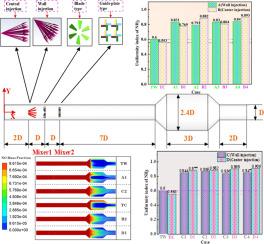Influence and correlation analysis of urea injection method and mixer combination on SCR performance
IF 3.9
3区 工程技术
Q3 ENERGY & FUELS
Chemical Engineering and Processing - Process Intensification
Pub Date : 2025-08-16
DOI:10.1016/j.cep.2025.110513
引用次数: 0
Abstract
As emission standards have been tightened globally, reducing nitrogen oxide (NOx) emissions is a strict challenge for the internal combustion engine industry. In this paper, it aims to explore the effects of different urea injection methods and mixer combinations on the performance of the selective catalytic reduction (SCR) system, as well as to perform correlation analysis by using the computational fluid dynamics (CFD) method. Firstly, the total SCR system model including a urea injection device and mixer has been built after the numerical simulation method was validated by comparing the results of the experimental data. Secondly, the effects of different injection methods and mixer configurations on turbulence energy, ammonia (NH₃) distribution uniformity, pressure drop, and NOx reduction (de-NOx) efficiency were analyzed. It is revealed that the mixer combination can significantly improve turbulence energy and NH₃ uniformity. The center injection method can provide better NH₃ uniformity and lower pressure drop compared to the wall injection method. Among the double mixers, the T-E type mixer is demonstrated to have superior de-NOx efficiency, while the E-type mixer excels in turbulence generation and mixing. Finally, the Analytic Hierarchy Process (AHP) has been used to assign weights to performance indicators, and the Technique for Order of Preference by Similarity to Ideal Solution (TOPSIS) identified Case D1 as the optimal configuration. For the T-E type mixer, de-NOx efficiency can be improved by over 10 %. For the center injection method, the pressure drop is reduced by 15 % and NH₃ uniformity is enhanced by 20 %. It is highlighted that the urea injection method and mixer combination play a critical role in optimizing SCR system performance and efficiency. At the same time, it also provides a systematic approach to solving problems by comprehensively considering the coordinated coupling actions between various components of the entire SCR system.

尿素注入方式和混合器组合对SCR性能的影响及相关性分析
随着全球排放标准的不断收紧,减少氮氧化物(NOx)的排放对内燃机行业来说是一项严峻的挑战。本文旨在探讨不同尿素喷射方式和混合器组合对选择性催化还原(SCR)体系性能的影响,并利用计算流体力学(CFD)方法进行相关性分析。首先,通过与实验数据的对比,验证了数值模拟方法的有效性,建立了包括尿素喷射装置和混合器在内的全SCR系统模型。其次,分析了不同注入方式和混合器配置对湍流能量、氨(NH₃)分布均匀性、压降和NOx还原(de-NOx)效率的影响。结果表明,混合器组合可以显著提高湍流能和NH₃均匀性。与壁注法相比,中心注法可以提供更好的NH₃均匀性和更低的压降。在双混频器中,T-E型混频器具有较好的脱硝效率,而e型混频器在湍流产生和混合方面表现较好。最后,采用层次分析法(AHP)对绩效指标进行权重分配,并采用与理想解决方案相似的偏好排序技术(TOPSIS)将案例D1确定为最优配置。对于T-E型混合器,脱硝效率可提高10%以上。对于中心注射方法,压降降低了15%,NH₃均匀性提高了20%。强调了尿素注入方式和混合器组合对优化SCR系统性能和效率的关键作用。同时,通过综合考虑整个SCR系统各部件之间的协调耦合作用,为解决问题提供了一种系统的方法。
本文章由计算机程序翻译,如有差异,请以英文原文为准。
求助全文
约1分钟内获得全文
求助全文
来源期刊
CiteScore
7.80
自引率
9.30%
发文量
408
审稿时长
49 days
期刊介绍:
Chemical Engineering and Processing: Process Intensification is intended for practicing researchers in industry and academia, working in the field of Process Engineering and related to the subject of Process Intensification.Articles published in the Journal demonstrate how novel discoveries, developments and theories in the field of Process Engineering and in particular Process Intensification may be used for analysis and design of innovative equipment and processing methods with substantially improved sustainability, efficiency and environmental performance.

 求助内容:
求助内容: 应助结果提醒方式:
应助结果提醒方式:


